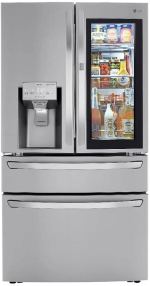How to Defrost a Samsung Refrigerator
Is there a built-in process or is it up to me?
If you're asking , “How to defrost a Samsung Refrigerator?” then you've come to the right place. We know how to help you through this process whether it's something you can do by pushing a few buttons or if you have to empty the entire thing out.
Whether you have just purchased a Samsung refrigerator or are an old hand at maintaining your appliance, knowing how to defrost your Samsung refrigerator is vital.
Samsung is a global brand renowned for its innovation and quality appliances that simplify daily chores. Despite the high-end features, like all other refrigerators, your Samsung refrigerator may also need defrosting occasionally.
No worries - we will help you answer all of these questions.
Before we jump into the different defrosting processes in how to defrost a Samsung refrigerator, it's important to understand when a Samsung refrigerator needs defrosting. If you're seeing things like: All of these could be signs that your Samsung refrigerator is in need of a defrosting. Samsung, a brand renowned for its commitment to innovation and user-friendly appliances, has incorporated a unique Forced Defrost function in most of its refrigerators.This advanced feature allows you to initiate defrosting at your convenience, minimizing any interruption to your day-to-day routine.
The Forced Defrost function is a feature in many Samsung refrigerator
models. This function allows you to start the defrosting process automatically, offering you more control over the maintenance of your
appliance. When you turn it on, this feature should easily defrost your
refrigerator. This feature helps prevent ice build-up, which can affect the
appliance's performance. It is found in many Samsung refrigerator models,
including but not limited to the Samsung Family Hub series, Samsung
Side-by-Side series, and the Samsung French Door series. To find out if your
refrigerator has this function, refer to your specific model's user
manual or contact Samsung support for assistance. Remember, using this function in the right way will help your fridge last longer
and work better, making your kitchen experience more enjoyable. Keep a close eye on the above items during defrosting to ensure
they remain safe to eat.
To activate this feature, you must press the specific buttons on the fridge's display panel, as the user manual indicates. (We would add it here but each model has it's own specific way of doing this.) If you have tried to use the 'Forced Defrost' function and it wasn't enough or your refrigerator doesn't have that function then we have you covered. Here's a step-by-step guide on how to defrost a Samsung refrigerator the right way. The first step to defrost a Samsung refrigerator is to empty all the contents. You'll want to ensure the refrigerator and freezer compartments are empty. Remember to store the perishable items in a cooler with ice to prevent them from spoiling. Next, disconnect your Samsung refrigerator from the power source. Doing this makes sure that the defrosting process is safe and effective. The last thing you want to do is leave your fridge open for any period of time and it still be trying to cool. Remove all the shelves and drawers from your Samsung refrigerator to make defrosting more manageable and allow the built-up ice to melt and drain out more easily. This will also make it easier to contain any dripping/leaking water as it melts. Now, let nature take its course. Leave the doors of your Samsung refrigerator open to allow the ice to melt naturally, keeping your fridge from growing mold. (If you close the doors, there is a good chance that this can happen.) Generally, you should allow a minimum of 6-8 hours for the process. When we/ve been told by repairmen to do this process they stated to leave everything open for up to 48 hours to ensure everything inside has plenty of time to dry. It's often best to plan for the defrosting process to occur overnight or when you won't need access to your refrigerator. As the ice melts, cleaning up the water is essential to prevent slip hazards and water damage. Use towels or a mop to soak up the water. Be sure to remove and replace them as soon as they get damp. After the ice melts and you've cleaned up the water, you can plug your Samsung refrigerator back in. Replace the shelves and drawers and return the food items. Defrosting a Samsung refrigerator may seem daunting, but with these easy steps, it becomes a manageable and straightforward process. Regular care and maintenance will ensure your Samsung refrigerator remains in optimum condition, reducing the need for frequent defrosting. Remember, a well-maintained Samsung refrigerator leads to less food wastage, energy efficiency, and a happier, stress-free life. And isn't that what we all want at the end of the day? Regular maintenance of your Samsung refrigerator can help prevent frequent defrosting. It's advisable to:How to Defrost a Samsung Refrigerator:
Signs it's time to defrost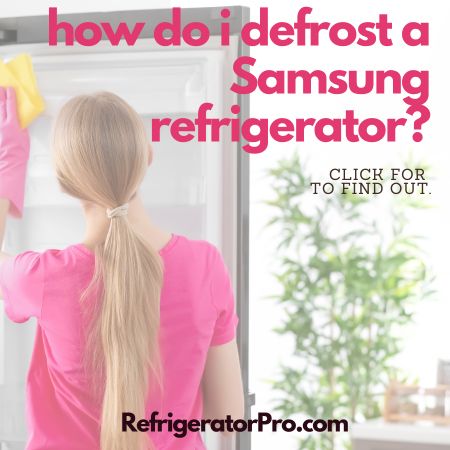
How to Defrost a Samsung Refrigerator:
Do Samsung Refrigerators have a Defrost Mode?
To start it up take a look your user manual for
the most accurate information on how to do so.
Before activating Forced Defrost it's recommended to empty your fridge. The way that it defrosts your refrigerator is by thawing any frost build-up which means
slightly increasing the refrigerator's internal temperature. Although the
risk is small, there is a chance of some items, particularly those
sensitive to temperature changes, spoiling, or developing freezer burn.
The most susceptible items include products like:
-milk, cheese, and yogurt, which can spoil quickly if not kept at
a constant temperature.
-raw meat, poultry, seafood, and
their cooked counterparts are highly perishable and can become unsafe if
exposed to warmer temperatures
-fresh fruits and vegetables, eggs, and leftovers.
How to Defrost a Samsung Refrigerator:
A Step-by-Step Guide
Step 1: Empty Your Fridge
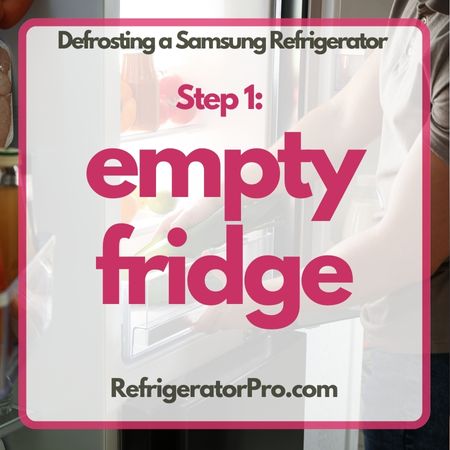
While emptying your fridge, it's an excellent opportunity to evaluate the items you're storing. Check the expiration dates of all products, and discard anything past its prime.
Similarly, if you find items you no longer need or things you have forgotten about, consider whether they're worth keeping. This regular checking of dates and things lurking in the back corners can help:
2. Turn Off the Power Supply:
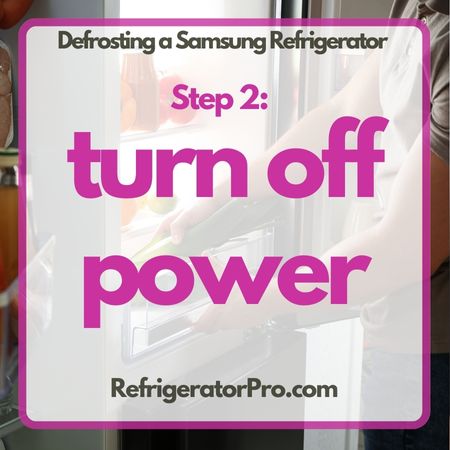
Doing it this way ensures the fridge no longer receives any power. Make sure to keep the plug in a secure place away from children and pets until the defrosting process is complete to also prevent an accidental re-connection.
Step 3: Remove the Shelves and Drawers
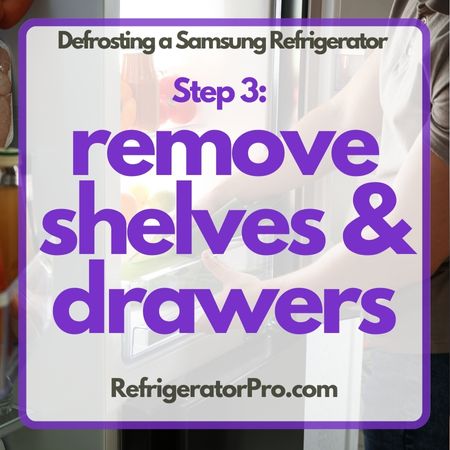
When removing the shelves and drawers from your Samsung refrigerator, be sure to handle them with care. These components are typically made of glass or plastic that can easily crack or break if mishandled.
Use both hands to gently lift each shelf and drawer out of place to prevent damage. Additionally, remember to clean off any spilled food or residue on them before storing them away. Cleaning them off not only helps to make it look so much better when you turn it bacck on but also keeps will help to keep it smelling much better when you put them back in after defrosting.
Step 4: Defrost

The timeline for defrosting your Samsung refrigerator can vary considerably, primarily depending on the ice build-up and the ambient temperature.
This process could take several hours, so be patient.
During this process, the frost in your freezer melts. As this happens the ice melts into water and naturally will flow down toward the drainage channels of your refrigerator. These are typically located at the back or bottom of your refrigerator.
You'll want to know where these are and make sure they are clear of any obstructions. This process is a routine and necessary one that helps your refrigerator keep optimal cooling performance, lower energy consumption, and extend the overall lifespan of the appliance.
Step 5: Clean Up
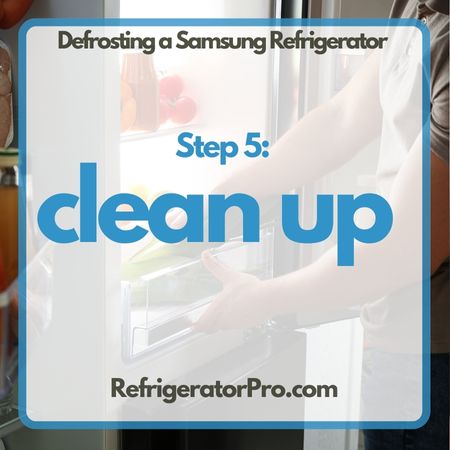
Regularly mopping the melting water prevents it from pooling around your appliances and kitchen floor. Being attentive to the process also allows you to spot any issues early and keeping them from causing some costly repairs and ensures the longevity of your refrigerator.
Step 6: Turn It Back On
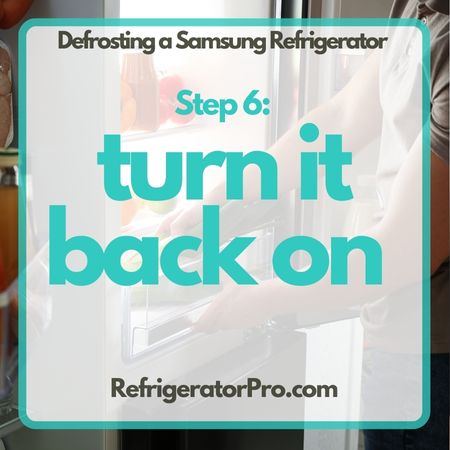
When turning your refrigerator back on after defrosting, it's essential to give it time to reach the optimal cooling temperature before restocking it with food.
Leaving the fridge empty for about an hour or two allows it to cool down effectively. Waiting until it's cold to put the food back in ensures that when you return your food items, they are kept at a safe temperature, preventing spoilage and ensuring the freshness and quality of your groceries.
How to Defrost a Samsung Refrigerator:
How to Avoid Regular Defrosting
Keep the temperature settings at the manufacturer's recommended level
Avoid leaving the refrigerator door open for extended periods.
Try to minimize the number of times you open the refrigerator door, and
when you do, close it as quickly as possible to prevent warm air from
entering and causing frost.
Avoid overfilling your refrigerator as it can restrict airflow, leading to frost build-up.
Lastly, ensure that all food items, specifically warm leftovers, are
adequately cooled and covered before placing them in the refrigerator.
Doing this process can prevent moisture from escaping into the fridge,
which could contribute to frost formation.
Implementing these good usage habits can help prevent the need for frequent defrosting.
Recent Articles
-
Top 10 Refrigerators 2025 - Editor's Picks and Reviews
Jun 24, 25 03:58 AM
Discover the Top 10 Refrigerators 2025. Our editors rank the best models for every budget, kitchen size and style -- and help you find the best price. -
LG, Bottom Freezer, LDC22720ST
May 02, 24 01:00 AM
Bought an LG Bottom freezer refrigerator from a well known explanation point department store. And purchased the 10 year warranty for major components. -
Is it safe to set a full size refrigerator on carpet?
Jan 18, 24 05:18 PM
I have a full size refrigerator with top freezer. Is it safe to run it setting on a carpeted floor, if not what can I put under it? The unit is brand



